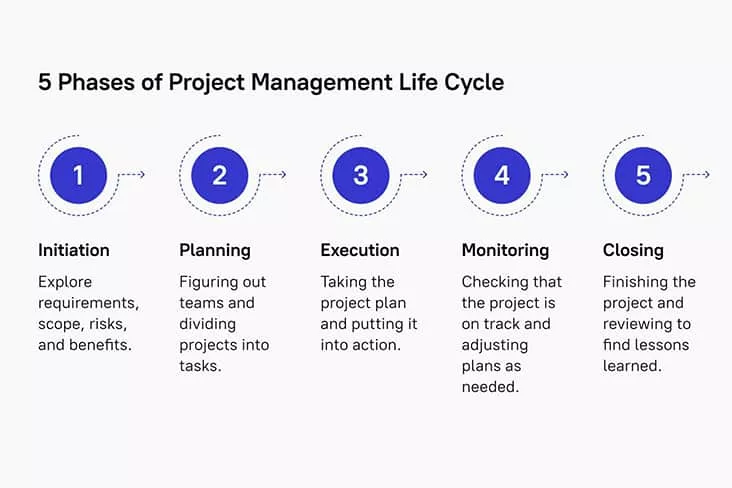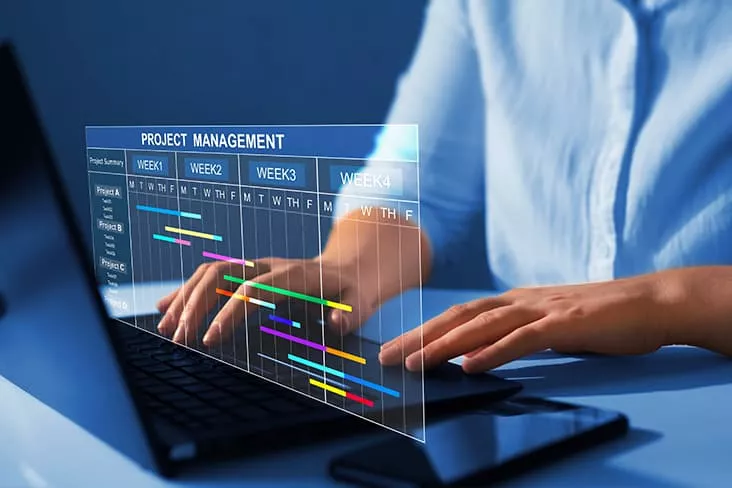
Effective project management may reduce the wastage of resources and funds. That's why an understanding of the project management life cycle is crucial whether you're working on a small project or a massive challenge with great corporate importance.
Find out five key project management phases that will help you optimize your next project and enable your team to work toward a well-organized plan in the development process.
Stfalcon follows the project management life cycle to deliver successful digital solutions. Having more than 15 years of experience, we guide projects through initiation, planning, execution, monitoring, and closing, ensuring timely, efficient, and high-quality results across web and mobile app development, custom software, and system integration.
Project Management Phases Overview
Project management is the process of planning, performing, and monitoring a set of tasks to achieve objectives within budget and on time.
Project management methodology is often misunderstood. Many professionals consider it as project time management, but it is actually much more than that. Luckily, we've put together a simple guide to the 5 phases of the project management life cycle.
Why is it important to know these five stages of project management? Understanding the project management phases will help you implement more efficient internal processes with project management software.

The phases of project management are the life cycle of the development process. Understanding this cycle makes it possible to implement more efficient internal processes and better manage teams with the help of software. So, according to the model proposed by the Project Management Institute (PMI), 5 Phases of the Project Management Life Cycle are:
1. Initiation
2. Planning
3. Execution
4. Performance & Control
5. Project Close
While this might seem banal, actually, each phase of the project management life cycle is an important part of the organizational structure and a mandatory guideline for setting up systematic work in the project. We will describe how to work on each of them.
Want a web app that does more?
Let's build a solution that's smart, sleek, and powerful.
Alina
Client Manager

What are the Different Stages of Project Management?
The Project Management Body of Knowledge, or PMBOK, when considering Project Management Life Cycle 5 Phases of the Project also refers to the above five stages.
As a rule, the Phases of the Project Management Life Cycle go sequentially, one by one. Despite its versatility, this structure is a conditional classification; the five stages can be changed if necessary. If there are changes during implantation, you can always return to the planning stage to adjust the work of the project team in the future.

Now, let’s look at each phase of the life cycle separately.
Project Phase 1: Concept & Initiation
The initiation phase means the start of work on a concept. To get started, determine what the task is for the team and whether your idea will help solve the problem. If the answer is yes, start writing the concept and business case, as well as looking for partners.
The initiation phase includes a lot of discussions, research, and analysis. When you meet potential partners, find out what they are interested in, what projects they have had in the past, and what they expect from the future. The task here is to determine goals, the implementation of which will lead to the expected result.
You need to create a project charter. It is important to fix the theses and agreements in the project charter. The charter is a short document that describes the project. It is a necessary component of planning. It is used throughout the life cycle of the project and helps to resolve all issues in the workflow.
A project charter contains the following information:
- Purpose and mission
- Project Advantages
- Possible risks
- Planned budget and timeline
- Key partners/stakeholders
- General overview of the budget
Project Phase 2: Project Planning
After signing documents and when the terms are approved by the interested parties, it is time for the project planning phase. The project manager now creates a detailed roadmap. Each team member can look through it at any phase of the workflow. The document contains details and goals that meet the expectations of the parties.
In the project planning phase, you need to divide the workflow into smaller tasks, assign roles to successfully manage the team, develop a step-by-step sequence of tasks, and set deadlines. For a better chance of success, it is important to make sure that the project plan contains all the necessary information.
The Gantt chart will help you through all phases of the lifecycle. It is an awesome tool for creating and controlling a roadmap. With a Gantt chart, you can also:
- Create dependencies and milestones
- Monitor the workload of each team member
- Interact with the team
- Create reports
- Export files to popular formats
- Work with project portfolios
- Share charts
- Create work and personal calendars and much more
After the schedule is ready, responsibilities are divided, and when you identify possible risks and prevention of them when the budget is planned, it is time for the meeting.
At the meeting, the PM presents the project and its goals, discusses the most important phases of the project plan with the team, FAQ sessions, and introduces tools that will be used in the development process. Team members should clearly understand the planning process and its implementation.
It is recommended to give the team access to the project plan. Thus, participants will know all changes in the workflow.
Project Phase 3: Launch or Execution
After approving the project, when the team is ready to start, it is time for the execution phase.
The task of the PM at the execution stage is to control the launch of the work of all departments and make sure that everyone is clear about the work.
Project Phase 4: Project Performance & Control
This phase usually coincides with the initiation phase. The PM has to ensure that team members follow the plan.
In this phase of the life cycle, the PM has to control resources and deadlines. He or she coordinates teams and makes changes to the project plan in case of unexpected circumstances.
It is absolutely normal to make changes in the plan during the control phase. Flexibility is the key because the sooner an issue is identified, the sooner it will be fixed. You have to remember that all innovations in the plan have to be agreed upon with the client.
Hold interim meetings with the team. At meetings, the PM collects feedback from project members and discusses adjustments. Also, discussions of controversial problems lead to more effective solutions.
Project Phase 5: Closure
The closure phase is the final stage of the project management lifecycle, marking the official end of the project. But don’t immediately switch to the next task. You need to leave a pleasant impression of the work of the team:
- Leave the project along with the documents to the client or to the team that will lead it in the future.
- Work on the bugs. At this final meeting, the team will know the successes and failures of the project.
- Report the results. The success of the project must be visible to clients and executives who are interested in the results of team members.
- Place documentation in a centralized repository. Access to it must be easy in the future.
The project is now officially completed.

How the Discovery Phase Contributes to Efficient Project Management
It may seem that the Discovery phase is needed only when developing a project with unclear requirements. In fact, there are several factors.
1. The discovery phase gives better understanding of business requirements - when the scope is not clear enough, but the client requires: evaluate the project, "subscribe" to fixed-price, start work as soon as possible to meet the deadline, to work out the technical side of the solution.
2. This stage is very important in the project management lifecycle when the scope is clear, but it is not known what the client already has in terms of the systems and infrastructure used. It's one thing to develop a project from scratch, it's another to refine an existing one, integrating external systems along the way.
The discovery phase will help determine whether improvements make sense, how much they can cost, and how long they will take. In practice, there were examples when customers just wanted to understand if they could continue to operate their system or if it would be easier to rewrite it from scratch.
3. The discovery stage makes it possible to refine requirements that have already been worked out to a level that will allow the engineering team to start development: that is, to get a backlog at the level of user stories and more details.
To fully develop a Discovery phase, a team consisting of an experienced PM, a business analyst, an architect, developers, and a UI/UX consultant should participate in it.
The PM, as a rule, is present from the first to the last day of Discovery, as he communicates with the client, and draws up a proposal. A business analyst is needed to study the requirements and prepare documentation and therefore is also usually present on the project from the first to the last day.
Developers are most often involved in the evaluation phase, as well as in prototyping. An architect and a UI/UX specialist participate in Discovery as needed.
The role of the project manager at Discovery is twofold: on the one hand, he, as a project management specialist, deals with everything that relates to the preparation of the “main” project plan and the preparation of documentation. On the other hand, he coordinates the Discovery project itself, facilitates the main meetings, and manages the Discovery team.
Conclusion
The heart of the project begins to beat in the first phase of initiation. The project steps are based on scientific knowledge, methodology, and experience.
Briefly: the main Phases of the Project Management Life Cycle
- Initiation – the start of work. Management solves organizational issues, makes plans, and documents the main points.
Planning – the manager uses the chosen methodology and formulates specific goals. If necessary, he or she uses additional tools and introduces metrics to assess the effectiveness of the team.
Execution – the performers work on tasks, and the manager monitors compliance with the schedule.
Performance and Control – the manager records achievements and compares them with the original goals, and KPI.
Completion – the team holds a final meeting with customers, makes conclusions, and the final project.
Project managers must be able to manage resources to complete a specific project on time, within budget, and without violating specifications and discovery services in software development will help with it. The project manager is the link between the organization and the customer and must be able to combine the customer's expectations with what can and should be done.
Stfalcon is a team of experienced software developers, designers, business analysts, and project managers, that can implement your idea into reality. If you want the best software solution to be done, just call or email us. Let’s work together!
About the Author
Vitalii is a Project Manager with extensive knowledge and experience in fields that matter for a project success. He has a proven track record in coordinating a number of large-scale projects from idea to deployment. Currently, he is working with the Stfalcon team.
Now that you know the 5 phases of the Project Management Life Cycle, enhance your idea with our comprehensive whitepaper, "How to Prioritize Your Time." Gain expert insights into strategic decision-making, efficiency enhancement, and productivity boost.



